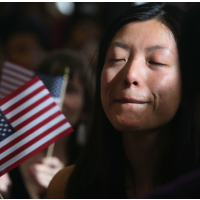New Immigrants from China and India Now Outnumber Immigrants from Mexico
 Chinese immigrant Yi Shu overcome with emotion on becoming U.S. citizen, 2013 (photo: John Moore, Getty Images)
Chinese immigrant Yi Shu overcome with emotion on becoming U.S. citizen, 2013 (photo: John Moore, Getty Images)
The debate over immigration in the United States has a new geographic direction. No longer is Mexico the leading country for new immigrants into the U.S., according to figures from the U.S. Census Bureau.
As of 2013, China and India sent more immigrants to the U.S. than Mexico, Census figures show. About 147,000 Chinese immigrants arrived two years ago, followed by India with 129,000. Mexico was third, sending 125,000 to the U.S.
Only a year earlier, Mexico had still held the lead in U.S. immigrants, and less than a decade ago, Mexican immigration exceeded the influx from India and China by sixfold each. But during this past decade, Chinese immigration has almost tripled, while the number of Indian immigrants has more than doubled.
The shift is “remarkable” due to how rapidly it occurred, said Muzaffar Chishti and Faye Hipsman of the Migration Policy Institute.
“China and India are the world’s most populous countries, and are becoming increasingly integrated into the global economy,” they wrote. “As their national economies have grown, per capita incomes have risen—along with access to global travel and means to pay for education abroad.”
While Indian and Chinese migration has risen steadily, the rate of Mexican immigration has declined at a much more rapid pace.
In spite of this change, “Latinos still make up the largest racial or ethnic minority group in the United States,” wrote Esther Yu-His Lee at ThinkProgress. ”But at least two-thirds of them are now born in the United States.”
However, Chinese immigrants constitute 65.4% of the foreign-born population.
Lee added that Chinese immigrants must deal with the “model minority” stereotype, which says children of these new residents are bound to succeed and wind up attending Ivy League schools.
This “can have serious drawbacks on individuals who may lack the tools to fully integrate into society,” Lee points out.
“Among Latinos, there might be more of a narrative around their racial position in the U.S.,” Dr. Janelle Wong, director of the Asian American Studies Program and Resource Center at the University of Maryland, told ThinkProgress. “For Chinese immigrants, that narrative is still developing. There’s a lot of variation in the community and so I see quite a bit of complicated thinking about where Chinese immigrants fit into the larger racial landscape… They don’t feel a lot of belonging.”
-Noel Brinkerhoff, Danny Biederman
To Learn More:
The Damaging Effects Of The ‘Model Minority’ Myth (by Esther Yu-Hsi Lee, ThinkProgress)
The Place-of-Birth Composition of Immigrants to the United States: 2000 to 2013 (by Eric B. Jensen, Anthony Knapp, C. Peter Borsella, and Kathleen Nestor, U.S. Census Bureau) (pdf)
In Historic Shift, New Migration Flows from Mexico Fall Below Those from China and India (by Muzaffar Chishti and Faye Hipsman, Migration Policy Institute)
Rich Chinese Flee to United States…and Bring Their Money with Them (by Noel Brinkerhoff, AllGov)
Border Patrol Dealing with Increased Illegal Immigrants from China (by Danny Biederman and Noel Brinkerhoff, AllGov)
- Top Stories
- Unusual News
- Where is the Money Going?
- Controversies
- U.S. and the World
- Appointments and Resignations
- Latest News
- Trump to Stop Deportations If…
- Trump Denounces World Series
- What If China Invaded the United States?
- Donald Trump Has a Mental Health Problem and It Has a Name
- Trump Goes on Renaming Frenzy






Comments